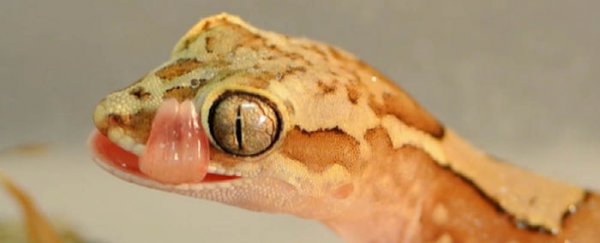
Forget water off a duck's back, researchers from Queensland, Australia, have discovered that geckos are so water-repellant, droplets explode off of them.
As you can see in the slow-motion footage above, tiny hair-like structures on the geckos' backs are so springy that the water droplets fly off them like popping corn kernels. This ability, which the researchers are calling 'geckovescence', effectively makes it impossible for the lizards to get dirty, even in dusty deserts.
A similar technique has been observed on insects and plants before, and also has been replicated in artificial hydrophobic materials, but this is the first time researchers have discovered it in a vertebrate animal. And this particular water-repelling strategy seems to be unique to the lizards.
The team, involving researchers from James Cook University in Townsville, first noticed the ability when they saw that box-patterened geckos, Lucasium steindachneri, had small water droplets condensing on their scales in humid conditions, rather than forming a thin film on moisture on their skin.
After investigating further, they found that the lizards are covered in hundreds of thousands of dense, minuscule hair-like spines called spinules.
These spinules create work on a basic level by creating little air pockets against the geckos' skin that cause the droplets to merge into each other.
"If you have seen how drops of water roll off a car after it is waxed, or off a couch that's had protective spray used on it, you've seen the process happening," said Lin Schwarzkopf from James Cook University in a press release. "The wax and spray make the surface very bumpy at micro and nano levels, and the water droplets remain as little balls, which roll easily and come off with gravity or even a slight wind."
But the spinules have an even more dramatic effect because they actually send these droplets flying. This is because they herd the tiny droplets together to merge them into larger droplets that release energy as they combine. When these droplets become large enough, sufficient energy is released to propel the droplets off the surface with enough force to clean the reptiles, jumping like popcorn off the skin.
Box-patterned geckos live in semi-arid habitats, with little rain but they often have dew form on them overnight, and Schwarzkopf believes that the process may have evolved to help keep geckos clean.
The unique strategy could now help researchers learn how to keep objects clean and dry, and create super-hydrophobic materials and clothing that never need to be washed. The research has been published in the Journal of the Royal Society Interface.
Love animals? Find out more about studying biological sciences at James Cook University.
